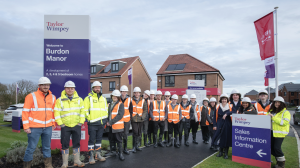
STARK UK wins HR Excellence Award by putting branch teams at the heart
STARK Building Materials UK has won the prestigious HR Excellence Award for Best HR Technology Strategy, in partnership with AdviserPlus. The Award was made in recognition of the successful collaboration between STARK UK, one of the UK’s leading group of builders’ merchants and materials distributors, and technology partner AdviserPlus, who together delivered a bespoke digital Employee Relations (ER) solution to support the company’s branch managers to self-serve people matters. Over the past two and a half years, STARK UK has been undertaking a comprehensive organisation transformation to provide the form of modern merchant proposition that general builders and the professional trades need. Central to the company’s improvements has been simplifying the organisation to put branch teams at the heart of its now highly efficient operations so that they are in the best position to support customers with their business and project needs. Providing branch teams with the right technology solutions has helped make line managers’ people management tasks easier and quicker to complete. Giving managers a technology-enabled approach to ER has also boosted their capability and confidence, as part of a transformed colleague experience. Carol Kavanagh, STARK UK’s HR Director said: “Focusing on the things that service our branch colleagues is core to our HR transformation strategy. Increasingly, we are working in partnership with branch teams to make sure the solutions we develop match their needs. There’s still lots to do and I am hugely proud of how the team continues to deliver at pace, engaging the business and always with our colleagues and customers in mind.” Simon Fowler, CEO of AdviserPlus and Empowering People Group, added: “This award is a brilliant recognition of the power of combining technology and partnerships that align with business goals. Working with STARK UK to build a solution that genuinely empowers their managers and transforms their employee experience perfectly aligns with our mission. It’s a testament to what can be achieved when innovation and trust come together to simplify complex HR challenges.” With 70% of employee relations tasks now manager-led, the outsourced ER advice has helped to ensure that HR support can be focused on the other important people areas that will help branch managers the most. Building, Design & Construction Magazine | The Choice of Industry Professionals

Taylor Wimpey showcases entry-level construction careers during Education Secretary visit
Taylor Wimpey North East welcomed MP Bridget Phillipson, Secretary of State for Education, and students from Harry Watts Academy to its Burdon Manor development for an immersive construction careers experience. The visit began with a presentation at the school, delivered by Ben McKie, Trainee Assistant Quantity Surveyor, and Ellen Page, Assistant Engineer and representative from the Young Persons Forum. Students then took part in a full site induction, before exploring the site and seeing the different stages of construction in action. Accompanied by Ben McKie, Ellen Page and Bridget Phillipson MP, students gained insight into the range of career opportunities available within the industry. The day concluded with an informal question-and-answer session over lunch, giving students the chance to speak directly with industry professionals. Ben McKie, Trainee Assistant Quantity Surveyor at Taylor Wimpey North East, said: “The students gained a real insight into life on a live construction site, from their induction, through to exploring the showhomes and seeing different roles in action. It was a great opportunity to showcase the variety of careers available, and we’re looking forward to continuing our partnership in 2026.” Martin Thompson, class teacher at Harry Watts Academy, said: “The visit was an outstanding experience for our students and something they will remember for a long time. They came away with a far better understanding of what it is like to work on a construction site and the range of career opportunities available within the industry. The real-world experience they gained goes far beyond what a classroom can offer.” The initiative reflects Taylor Wimpey’s ongoing commitment to supporting young people and promoting careers in construction across the North East region. Building, Design & Construction Magazine | The Choice of Industry Professionals

Burges Salmon acts for Benniman on back-to-back transactions delivering major UK logistics and industrial projects
The Construction and Engineering team at Burges Salmon has advised independent construction company Benniman Limited on a series of significant projects across the UK. Led by director Christian Mulvihill, the firm provided legal support on large-scale developments for leading names in the logistics and industrial sectors. Notably, Burges Salmon advised Benniman on the creation of three new logistics and distribution facilities at Daventry International Rail Freight Terminal (DIRFT) in Northamptonshire. Totalling 618,000 sq ft, the schemes will deliver high-quality space and strengthen DIRFT’s position as a key hub for rail-connected logistics, supporting efficient supply chain operations and sustainable freight solutions. Further advice was provided across three other projects including on the construction of a c. 50,000 sq ft best-in-class industrial and warehousing estate in Reading, the development of eight industrial units in Milton Keynes totalling 200,765 sq ft., as well as recent work delivered for property developer Clowes Developments. The team also advised Benniman in relation to the construction of three industrial units in Birmingham on behalf of Coltham as well as a 57,000 sf ft unit in Worcester Six Business Park for Stoford. Christian Mulvihill, director at Burges Salmon, says: “We are delighted to have supported Benniman on these projects, which demonstrate the strength of the UK logistics and industrial sectors. Completing five transactions back-to-back within a short timeframe required careful co-ordination and a thorough understanding of contractual and regulatory issues. It is a testament to the strength and agility of our team that we were able to deliver seamless advice across multiple projects simultaneously, ensuring our client could move forward with confidence and efficiency.” Paul Barfoot, Commercial Director at Benniman, comments: “Delivering major projects concurrently was a significant undertaking, and Burges Salmon’s ability to manage the legal complexities was outstanding. Their proactive approach, responsiveness and sector expertise gave us the confidence to progress each development without delay.” With over 40 specialist lawyers working across the firm’s Built Environment, Infrastructure and Energy & Utilities sector groups, Burges Salmon has one of the largest construction and engineering legal teams in the UK and is a first port of call for highly complex and innovative projects. Building, Design & Construction Magazine | The Choice of Industry Professionals

Engineers scale iconic Liverpool tower for after-dark inspections
Technicians suspended nearly 140 metres in the air carried out tests on the concrete and steel of St Johns Beacon in Liverpool using specialist rope access techniques. RSK Group company CAN Structures was contracted to carry out a defect survey and concrete testing of the iconic Grade II listed communications tower following previous inspections in 2011 and 2015. Work was carried out on the 138-metre-high St Johns Beacon, originally built in 1969, through the night over the course of nine days so that the streets below could be closed during the works. CAN Project Manager Louis Thomas said: “We carried out acoustic hammer tests – tap tests – on the entire concrete façade of the tower. Defects were recorded and depth of carbonation and covermeter tests were taken. The steelwork at the top of the tower and the windows to the ‘doughnut’ also received a full visual inspection. “Access to the underside of the ‘doughnut’ proved particularly challenging. Initial access was gained through lighting openings on the underside of the tower, and we then put up rigging between the adjacent openings. The staging platform we call ‘CAN-Span’ was then winched up from ground level to enable technicians to get within touching distance of the underside of the tower to carry out their inspections.” Louis explained that, for safety, a considerable cordon was necessary. Several roads, footpaths and pedestrian areas within an extended footprint of the tower were closed by Liverpool City Council. Munroe K Asset Management manages the building. Director Roger Fulford said: “The Beacon tower is iconic in Liverpool and, like all buildings, needs to be inspected and maintained. For most buildings, the view while doing so is significantly less dramatic. The information gathered during this inspection will be used to assess maintenance schedules and inform us of the condition of the structure so that it can be future-proofed, ensuring it remains an integral part of the city’s skyline for many years to come.” St Johns Beacon is a notable feature of the city’s skyline and a popular destination for tourists, with the building’s first floor giving visitors 360° panoramic views of the city. It was refurbished between 1999 and 2000 and has been used as a revolving restaurant, a communications tower, offices and a tourist site. Building, Design & Construction Magazine | The Choice of Industry Professionals

Young unemployed offered training or job opportunities in construction – BCIS chief economist
Dr David Crosthwaite, BCIS – chief economist, said: There is a risk that schemes built around compliance or sanctions place young people into roles that do not align with their skills, interests or longer-term aspirations. For construction, which already faces persistent challenges attracting and retaining new entrants, the priority should be creating conditions that make the sector a positive and deliberate career choice rather than a default option. There is also the practical concern of placing inexperienced young people on potentially dangerous work sites without adequate training. Fundamentally, the industry is suffering from a skills shortage rather than a shortage of general labour, so the focus should be on building capability, not just filling labourer vacancies. At the same time, there could be clear benefits for employers. Many construction firms have stopped replacing workers or paused plans to grow their teams because of cost pressures and uncertainty in the market. If government programmes provide meaningful support with hiring and training costs, this could help firms take on young people they might otherwise be unable to afford to recruit or develop. That could strengthen early-career pipelines at a time when workforce capacity is one of the biggest constraints on delivery. Building, Design & Construction Magazine | The Choice of Industry Professionals

London Set for an Office Revival – If Planning Rules Keep Up
London could be on the brink of a major office construction surge, with developers arguing that the right conditions are finally lining up – provided the planning system becomes more flexible. Fresh analysis from the London Property Alliance and Knight Frank suggests that modernising the capital’s ageing office stock could generate an £84 billion economic uplift and release £262 billion in investment value. Their new report, Space for Change: Office space dynamics in central London, highlights the scale of the challenge: between 2018 and 2023, London’s central activities zone (broadly the area covered by Underground zone 1) lost around 14 million square feet of office space. Over the next five years, the capital is expected to face an 11 million square foot shortfall. Much of the existing stock is no longer fit for purpose. The report notes that 56% of central London offices – around 147 million square feet – are rated as secondary space, offering ageing, lower-quality environments that will fall short of mandatory sustainability requirements by 2030. As a result, upgrading or redeveloping these buildings is becoming increasingly urgent. Vacancy rates for prime space have tightened considerably. Availability of top-tier offices is near historic lows, with just 0.8% of prime and 1.7% of Grade A space currently unoccupied. Only a dozen very large single-floor offices above 40,000 square feet – the sort favoured by major firms consolidating staff – are on the market. Demand from occupiers is strong. Companies are actively searching for 10 million square feet of space, around 7% above the long-term average, propelled chiefly by financial and professional services firms. While 15.4 million square feet of new offices are due to complete between 2025 and 2029, a significant share is already pre-let or situated outside the high-demand areas of the City and West End. This pipeline not only falls short of replacing space lost since 2018, it also fails to meet current or future requirements. Representing central London’s leading developers and investors, the London Property Alliance is calling for a shift in approach, arguing that major office projects should be treated as essential economic infrastructure. They say planning and regulatory processes should be streamlined to improve development viability. Developers report that viability is one of the biggest barriers they face, made worse by a complex and often costly planning framework. They want planning authorities to simplify regulations, reduce obligations and lower the financial burden placed on new schemes. Ross Sayers, chair of the City Property Association and head of development management at Landsec, noted that rising construction, labour and finance costs, combined with growing planning obligations, are putting many projects under pressure. He stressed the need for collaborative, pragmatic solutions to ensure central London remains a world-class business hub. James Raynor, chair of the Westminster Property Association and chief executive of Grosvenor Property, warned that ageing office stock threatens future supply without intervention. He believes that modernising these buildings through flexible, forward-looking planning policies could unlock significant economic growth while supporting net-zero goals and local communities. Shabab Qadar, Knight Frank’s head of central London research and author of the report, described a systemic problem in the office market: demand for high-quality space continues to rise, but supply cannot keep up as buildings are repurposed and planning hurdles restrict redevelopment. He argues that the case for upgrading London’s older office stock has never been stronger. Building, Design & Construction Magazine | The Choice of Industry Professionals

